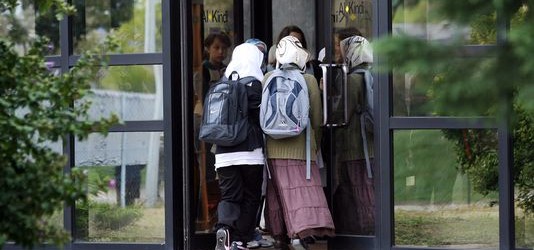Courts in the Swiss canton of Thurgau have overturned on appeal the cantonal school district’s decision to forbid two Albanian girls from wearing the headscarf to school. The story begins in 2011, when two 14-year-old girls were forbidden from wearing their headscarves to classes. What ensued was a two-year legal battle that saw the school’s decision approved once by the courts, then now overturned. Surprising to me is that the ruling found that a blanket ban on headscarves was disproportionate and without a sound legal basis for a general ruling. Not surprising to me, the leader of the school, Rolf Gmünder, was quoted (in the NZZ article, above) as planning to appeal, in order to gain the “sound legal basis” to move forward with an all-out headscarf ban.
Switzerland, in keeping with its status as confederation, does not have a national policy on headscarves per se. In its direct democracy system, many things decided at the federal level are by referendum (like the minaret ban), but a majority of issues are decided at the cantonal or communal/district level, and sometimes even case-by-case regarding individual schools. As such, unlike in France, there really haven’t been serious national initiatives on outlawing headscarves. Indeed, there has been local legislation or associative rules aimed at defining how girls and women dress, like the Sura al-Shawk case in Luzern (which I have written about previously at MMW) as well as the case of the swimming lessons for girls in Basel (also the topic of a previous article on this site), but as of yet no referendum (in a referendum-happy country) on access to education for girls and women in headscarves.
Arguments on the religious permissibility or mandatory nature (or not) of headscarves aside (my pet peeve in talks about Muslim women), this is an important step in providing equal access to education for women.
Too many girls are forced to choose against education because of these hijab bans meant to “protect” them. For example, while it is technically possible to wear a headscarf to French universities, this isn’t the case in French schools; therefore, a girl has to make it through high school without a headscarf in order to be able to wear one at university, which still doesn’t guarantee that your particular university will accept that you wear one. Implementing a “headscarf ban” at the high school level in Switzerland like the one in France would thus be detrimental to girls’ education here.
Switzerland, unlike other countries in Western Europe, got a significant increase in its “Muslim” population ten or so years later than other countries like France, and until recently had a successful guest worker program that made permanent residence less attractive than elsewhere, which is why we are just now seeing a rise in questions other countries in Western Europe addressed in the 1990s and 2000s. I hope that the “confederate” nature of Swiss democracy is such that these types of unfortunate decisions on hijab bans (unfortunate as in “why are we even having this discussion”) will continue to be made on a case-by-case basis which will allow more girls to go to, and finish, school.




